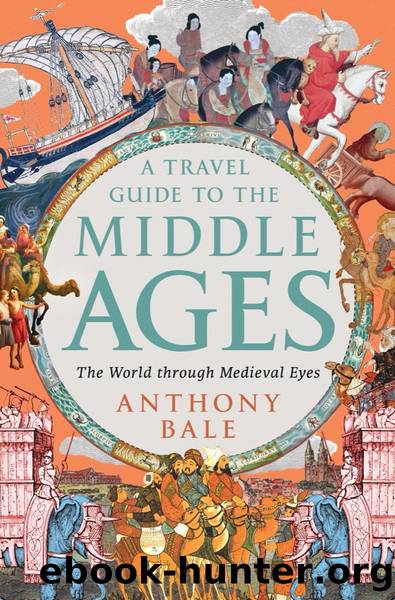A Travel Guide to the Middle Ages: The World Through Medieval Eyes by Bale Anthony

Author:Bale, Anthony
Language: eng
Format: epub
Publisher: W. W. Norton & Company
Published: 2024-04-23T00:00:00+00:00
9.
A Detour to Ethiopia
Aghmat â Rio del Oro â Malsa â Barara
South of the Holy Land and beyond Egypt lay Ethiopia, a vast terrain connected to the Mediterranean via the River Nile. The medieval kingdom of Ethiopia was somewhat cut off from Europe by deserts, distance and wars with Islamic rulers. Historically, it was an embattled and sometimes expansionist Christian empire with a significant Muslim minority. The kingdom, vying for supremacy with Muslim sultanates in the Horn of Africa, was focused on the central plateau, running north to south from the Dahlak archipelago in the Red Sea to Lake Shalla in the Ethiopian rift valley. The Ethiopian Church, established in the fourth century and united with the Coptic Church, built elaborate hall-basilicas throughout the country. These include the unique thirteenth-century buildings of Lalibela, a âNew Jerusalemâ of eleven elaborate churches hewn in the living rock. The complex includes its own Golgotha and Mount Sinai. Lalibela may well have been founded as a response to the Muslim conquest of Jerusalem in 1187, which made the journey there even more difficult. In time, to travel to Lalibela as a pilgrim was obligatory for medieval Ethiopian Christians.
Ethiopian Christians had communities at Jerusalem itself and in Egypt and Cyprus, where Europeans were most likely to come into contact with them.
However, to European minds, the borders of Ethiopia were utterly undefined and the term âEthiopiaâ was used for much of Africa. In one common definition, Ethiopia stretched from the Atlas Mountains to the end of Egypt, from the Atlantic to the Red Sea. Africa was, in European accounts, remarkable because it was huge, as if there was simply too much of it to account for. On the famous map of c. 1450 by Fra Mauro, a Venetian monk and cartographer, Ethiopia and its related realm of âAbassiaâ (Abyssinia) occupy almost half of the African continent, seeming to stretch from Africaâs southern tip to its north-western edge.
When Martin Behaim was dispatched by the Portuguese king on a âvoyage of discoveryâ to âEthiopiaâ in 1484, he sailed around west Africa, finding âanother worldâ, previously unknown to Europeans, in the vicinity of what are today the coasts of Gabon and Angola. When he came to make his Globe, less than ten years later, he relied instead on the accounts of Ptolemy and Marco Polo for his description of Ethiopia, showing the âEmperorâ of âAbassiaâ on his throne with a devout subject kneeling before him. This emperorâs people are Christian, says the Globe, âand trade gold and ivoryâ.
Medieval Ethiopia was long believed to be the home of marvellous (or monstrous) humans. Homer had called the Ethiopians âthe furthest of menâ, dwelling in a distant land beyond the seas. Mandeville, writing in his 1350s travel guide, said that Ethiopia, âa vast countryâ, was inhabited in the south by âutterly blackâ people (the name Aithiopes derives from the Greek for âburned visagesâ). Like many medieval writers, Mandeville saw geography as fundamentally linked to physiology; the definition of the Ethiopians by their
Download
This site does not store any files on its server. We only index and link to content provided by other sites. Please contact the content providers to delete copyright contents if any and email us, we'll remove relevant links or contents immediately.
China Rich Girlfriend by Kwan Kevin(3932)
The Silk Roads by Peter Frankopan(3835)
Annapurna by Maurice Herzog(2874)
Hot Thai Kitchen by Pailin Chongchitnant(2837)
Full Circle by Michael Palin(2804)
Okonomiyaki: Japanese Comfort Food by Saito Yoshio(2408)
City of Djinns: a year in Delhi by William Dalrymple(2156)
The Ogre by Doug Scott(2143)
Photographic Guide to the Birds of Indonesia by Strange Morten;(2108)
Tokyo by Rob Goss(2036)
Vietnam, Cambodia, Laos & Northern Thailand by Lonely Planet(2035)
Tokyo Geek's Guide: Manga, Anime, Gaming, Cosplay, Toys, Idols & More - The Ultimate Guide to Japan's Otaku Culture by Simone Gianni(1965)
Discover China Travel Guide by Lonely Planet(1881)
Everest the Cruel Way by Joe Tasker(1843)
China (Lonely Planet, 11th Edition)(1820)
Lonely Planet China(1771)
China Travel Guide by Lonely Planet(1756)
Top 10 Dubai and Abu Dhabi by DK Travel(1736)
Iranian Rappers And Persian Porn by Maslin Jamie(1728)
